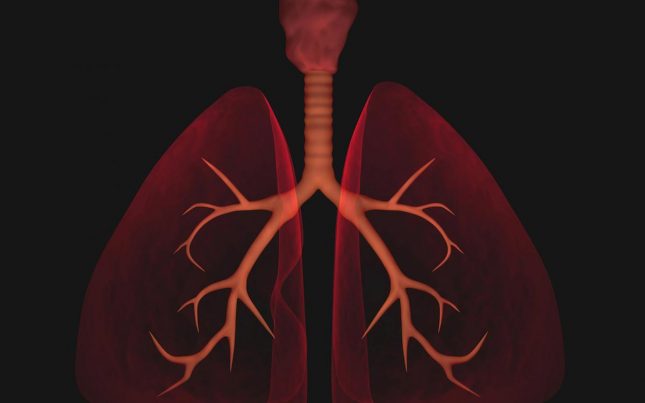
Bronchiectasis — causes, side effects and treatments at NaturalPedia.com
Tuesday, January 30, 2018 by Zoey Sky
http://www.naturalpedia.com/bronchiectasis-causes-side-effects-and-treatments-at-naturalpedia-com.html

Bronchiectasis refers to “the abnormal widening of the bronchi or their branches.” This usually results in a greater risk of infection. A bronchus (plural “bronchi”) is the airway in the respiratory tract that conducts air into the lungs.
When an individual is diagnosed with bronchiectasis, the bronchial tubes in their lungs are damaged due to inflammation or other causes. The smooth muscles of the bronchial tubes are also destroyed. The elasticity of the bronchi is often lost.
Bronchiectasis can be acquired or it may have a genetic origin. A lot of healthcare professional believe that bronchiectasis is a kind of chronic obstructive pulmonary disease (COPD), which includes diseases like chronic bronchitis and emphysema.
Known side effects of bronchiectasis
The side effects of bronchiectasis may include:
- A wet cough that persists despite antibiotics.
- Coughing up lots of sputum (phlegm/mucus).
- Feeling slightly breathless or being unable to exercise as much as you used to.
- Frequent chest infections (particularly with a bug called Pseudomonas aeruginosa).
- For young patients — asthma that is difficult to control and recurrent chest or ear infections.
Individuals at risk for bronchiectasis include:
- Patients with alpha-1 antiproteinase (alpha-1 antitrypsin) deficiency or an embryological defect called immotile cilia syndrome
- Individuals with cystic fibrosis
- Adolescents who develop lung infections with lung tissue destruction may be diagnosed with bronchiectasis when they are older.
- Individuals who have “recurrent lung infections, aspirate foreign bodies, have had a history of tuberculosis, or inflammatory bowel disease.”
- People who tend to use drugs heavily and consume copious amounts of alcohol.
- Individuals exposed to toxic gases/substances that damage lung tissue.
Body systems harmed by bronchiectasis
In healthy individuals, air passages in the respiratory system allow oxygen to enter the lungs and carbon dioxide to leave the body. The lungs normally have bronchial tubes that narrow smoothly towards the edges of each lung.
However, in patients with bronchiectasis, the bronchial tubes “widen and become collapsible and scarred.” The cilia (or the hair-like structures that clear mucus from the lungs) become ineffective, which lets the mucus build up. The mucus buildup allows bacteria to thrive. Ongoing infections increase inflammation, and this causes leads to exacerbated lung damage.
Food items or nutrients that may prevent bronchiectasis
The following foods or nutrients can help prevent bronchiectasis:
- Calcium fluoride and calcium phosphate — The former can restore the elasticity of tissues and the latter can strengthen tissues. Include both in your diet to help reduce the expansion of the bronchi and also strengthen its walls.
- Vitamin C and vitamin A — The first is a great immunity booster and can help reduce mucus while vitamin A can help prevent infections.
- Cod liver oil — It can help absorb calcium. Best paired with an increased calcium intake.
Treatments, management plans for bronchiectasis
The following treatments and management plans can help prevent bronchiectasis:
- Avoid “toxic fumes, gases, smoke, and injurious dusts.”
- Keep an eye on children so they don’t accidentally inhale foreign objects into the airways (referred to as aspiration).
- Avoid over-sedation caused by drugs or alcohol.
- Consult healthcare professionals for neurologic symptoms like impaired consciousness or gastrointestinal symptoms like “difficulty swallowing and regurgitation or coughing after eating” to prevent aspiration.
- Refrain from using mineral oil or petroleum jelly in or near the nose so it isn’t inhaled into the lungs.
Where to learn more
- The 6 Best Herbs for Asthma Treatment
- Arsenic exposure makes you more susceptible to influenza infections
- Bronchiectasis: Relief can be Found in Nature
- Cannabis oil from marijuana is having success treating COPD
Summary
Bronchiectasis refers to “the abnormal widening of the bronchi or their branches.” This usually results in a greater risk of infection.
When an individual is diagnosed with bronchiectasis, the bronchial tubes in their lungs are damaged due to inflammation or other causes.
In patients with bronchiectasis, the bronchial tubes “widen and become collapsible and scarred.” The cilia (or the hair-like structures that clear mucus from the lungs) become ineffective, which lets the mucus build up. The mucus buildup allows bacteria to thrive. Ongoing infections increase inflammation, and this causes leads to exacerbated lung damage.
Calcium fluoride and calcium phosphate, vitamin C and vitamin A, and cod liver oil can help prevent bronchiectasis.
Sources include:
Tagged Under: Tags: bronchiectasis





